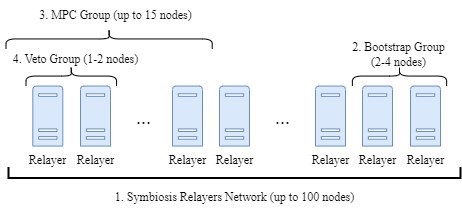Symbiosis processes cross-chain swaps through the relayers network – an off-chain group of relayer nodes that transfers information from one blockchain to another.
Let’s say you want to swap USDC on Ethereum for BUSD on BNB Chain. Relayers detect a corresponding request from Ethereum, confirm it, and pass it to the BNB Chain.
Here’s the unique point: the relayers network is powered by the MPC technology, not blockchain. Although relayer nodes run on top of Ethereum and other blockchains, they do not utilize their own chain of blocks. This approach allows us to reach a high level of security and scalability. Let’s see how it works.
What is MPC?
Multi-Party Computation (MPC) is a cryptographic technique that allows members of one group to compute something together – but without disclosing their data to each other.
Suppose you and your friends want to calculate your average salary, but no one wants to share what their wage is. That’s where you can use MPC. You share fragmented pieces of information with your friends – and these pieces make no sense while isolated, but when you mix them up and find the average, you will see the right number.
Why do we need MPC in crypto?
In the blockchain space, the MPC technique is used to sign transactions when the private key is divided between multiple parties.
Keeping a private key wholly in one place poses a number of risks. If a private key in a non-custodial wallet is stored on the user’s device, theft or loss of this key means the funds are lost. If a DeFi smart contract can be altered with only one admin’s private key, the possibility of fraudulent updates in such a contract increases.
To mitigate these risks, the private key can be divided across several parties. A transaction will be signed only when all (or most) of these parties use their fraction of the key. MPC is the technology that allows the parties to collectively sign the transaction without revealing their pieces of the private key to each other. Alone, these pieces are useless, but when combined, they create a valid signature. This prevents any single participant from creating the signature alone.
How does MPC work?
How do you sign a transaction when the key is divided into several pieces?
Let’s explore how crypto signatures work in general. When a newwallet address is created on the blockchain, a unique pair of public and private keys is generated. Whenever the owner of this wallet wants to send a transaction, they use the private key to sign it. Blockchain nodes verify the signature and confirm that the wallet owner really possesses this private key and has the right to send the funds.
The algorithm of signing a transaction via MPC is similar at its core. Here’s the difference: there are extra steps where a fragmented private key is generated and the full signature is made up using these fragments.
The MPC algorithm usually requires a quorum: the signature can only be valid if a threshold number of parties submit their pieces of the signature. This approach is called the TSS (Threshold Signature Scheme), and we use it to sign cross-chain transactions in Symbiosis.
MPC in Symbiosis: Relayers network made scalable and secure
The Symbiosis’ relayers network transfers signals between blockchains – and is not based on a blockchain itself. But how to make such a network secure? The answer is – with an MPC key spread across the relayer nodes. Here’s how it works, step-by-step:
- When the relayers network detects a request to send coins from one blockchain to another, the network must sign it with a TSS signature. Reaching a quorum of ⅔ relayer nodes is a requirement – but we went further and implemented something else to enhance security.
- In the relayers network, there’s a so-called veto group – a few trusted relayers whose participation is mandatory to create the TSS signature. If veto group members see a suspicious transaction, they don’t participate in TSS signature generation, so the signature is not created and the request to swap funds is rejected.

The structure of the relayers network. MPC group is a part of the relayers network active in a given 24-hour epoch. Find out more in the Docs.
- This is a unique approach of Symbiosis called the Hierarchical Threshold Signature Scheme (HTSS) model. The veto relayer node cannot generate the signature itself, but it can reject transactions – even when other relayer nodes are compromised.
- Trusted relayer nodes are added to the veto group by the Symbiosis team, but this will be done in a decentralized way by other relayers in the future.
Another perk of the МРС/HTSS signature is that, unlike blockchain nodes, relayer nodes don’t have to store the entire chain of blocks with the current state of the network. In blockchain, this is necessary to reach consensus between nodes. For relayers, the MPC key is enough. That’s why we call relayers network a stateless network, and it has the following advantages.
The benefits of using MPC in Symbiosis
- Highly secured transactions. The goal of the relayers network is to ensure data transfer from one blockchain to another in an unaltered form. The MPC mechanism with a quorum (threshold) and a veto group allows us to eliminate the risk of potentially malicious parties corrupting the cross-chain data bridge in their favor.
- Reduced barrier to entry for relayer node runners. Since they don’t have to store the entire copy of a blockchain, hardware requirements are significantly reduced. It becomes cheaper and easier to join the relayers network and maintain the relayer node, which makes the network more decentralized and robust.
- Symbiosis supports cross-chain swaps between EVM-compatible and incompatible blockchains (Solana, NEAR). This is possible because the blockchain-free MPC model allows working with different data formats.
Signing cross-chain swaps with an MPC-enabled relayers network allows Symbiosis to process these swaps in a fast and secure manner while keeping relayer nodes lightweight and easy to operate. Find out more about the relayers network and its evolution in our next articles.


Comments